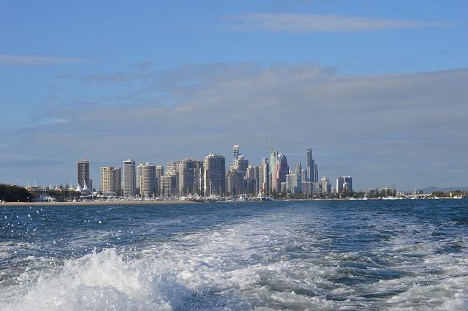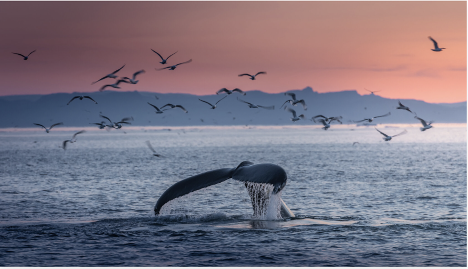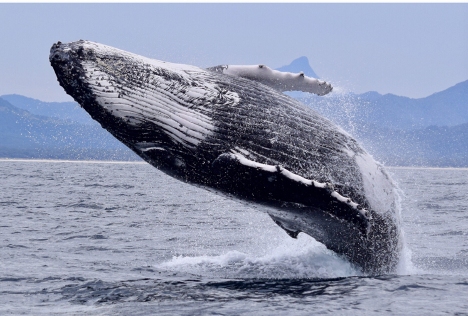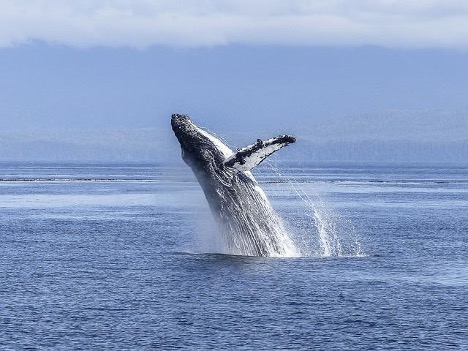We’re in whale watching season on the Gold Coast right now, which means Surfers Paradise is a must-visit destination if you’d like to see these incredible creatures up close. Read on to find out everything you need to know about whale watching season on the Gold Coast.
When Is Whale Watching Season Gold Coast?

Did you know that the Gold Coast has the most extended whale watching season in all of Australia? Whale watching season runs between June and October, with the best time being during August, which is when the peak of while migration and mating season occurs along the stretch of water called the ‘Humpback Whale Highway’. The best time of day is mornings and early afternoons. If you want to experience whale watching, now is the perfect time to book!
A Bit About Humpback Whales
Humpback whales, which get their name from a distinctive hump on their back, are huge mammals known for their size, their eerie and beautiful melodies, and their incredible acrobatic skills when they break through the water. Because they filter graze on tiny krill or small pelagic fish, humpback whales are not considered predatory and are completely safe to humans (other than through accidental collisions).
Humpback whales are mammals, which means they give birth to their young. These whales are renowned for their singing – males pursue females by creating elaborate melodies. The only creature known to attack and consume humpback whales is the killer whale (who only pursues juvenile humpbacks).
Every year, humpback whales migrate incredible distances between their feeding and breeding grounds – they feed near the poles and give birth in the tropics. Each year, individual humpback whales travel up to 25,000 km between these two areas. Humpback whales only eat in their winter feeding grounds and live off fat reserves for the rest of the year, including while migrating.
Humpback whales were once on the brink of extinction due to commercial whaling – but thankfully, there was a worldwide moratorium on this hunting in 1966, and thankfully their population has increased dramatically since then.
Fun Facts About Humpback Whales
1. Humpback whales grow up to 60 feet and weigh between 25,000 and 30,000 kg
2. Humpback whales can live for 80 to 90 years
3. Humpback whales have some of the longest migrations of any mammal, with some populations swimming 5,000 miles (8,047 km) between breeding and feeding grounds.
4. Humpback whales eat up to 1300 kg of food per day
5. Male humpback whales create and sing songs that can be heard up to 30 kilometres away
7. Humpback whales are active and can be seen breaching out of the water, slapping the surfacing with their fins and tails and twirling underwater.
What is the Humpback Whale Highway?
The Humpback Whale Highway is a 3000 km stretch of water from Western Australia to Antarctica. In Australia, approximately 35,000 whales migrate along this stretch of water every year as they make their way from Antarctica to sub-tropical breeding grounds such as the Gold Coast in Queensland. Now, you can’t see this highway by car; the only way to get in on the action is to take a boat out to the highway. Whale-watching is an unforgettable, mesmerising experience – there is honestly nothing like seeing these gentle giants up close in their natural environment. The Gold Coast is one of the best places to see these animals – and we offer the best whale watching Gold Coast has to offer.
Join Us for an Unforgettable Cruise on the Whale Highway!

If you want an unforgettable whale-watching experience, join us for the cruise of a lifetime. We will set off from Main Beach on the Gold Coast, and in just 20 minutes we will reach our vantage point for the Whale Highway. We’ll cruise around for 2.5 hours to make sure you can soak up all the stunning ocean views and enjoy uninterrupted whale-watching time – you might just see them perform tricks like tail slapping, spraying water and bursting out of the water!
With only a limited number of seats on board, we ensure you enjoy an intimate experience and create lifelong memories without the crowds. Plus our marine experts will tell you everything you need to know about these amazing animals and the important role they play in our ecosystem. Onboard purchases are available for your convenience! As well as majestic humpback whales, you can also expect to see bottlenose dolphins, Minke whales and gigantic whale sharks during whale-watching season on the Gold Coast!
As well as our whale watching cruises Gold Coast, we also offer:
Find out More About Our Whale-Watching Tours
Book a Whale-Watching Experience
Everything You Need to Know About the Gold Coast Whale Watching Season

Early Whale Watching Season – May, June & July
Humpbacks begin passing through the Gold Coast in mid to late May. Often this migration will be signalled by whale spotting in Sydney, which signals the creatures aren’t far away. During these seasons, you’ll see whales travelling north as they migrate towards the east coast of Australia to breed. You might even see Migaloo, the pure white humpback who made headlines when he was spotted back in 2009!
Mid Whale-Watching Season – August & September
During these months, you will see some humpback whales heading back south and some heading north. You will mostly see adult or juvenile whales, and occasionally you might spot a mother and calf. The number of whales increases later in the season because the mothers and their young stay in warmer waters until the calves are older. If you want to see mother and calves, late September is the best time to go whale-watching.
Late Whale–Watching Season – October & November
During this part of the season, you will see whales heading south because they’re heading to summer in the Antarctic. You are very likely to see mothers and their calves in these months. You might also see some orcas and killer whales.
So…When Is the Best Time to Go Whale-Watching on the Gold Coast?
This depends on what you want to see! Every month in the season has something special and unique to offer, so head on out and see these miraculous giants for yourself!
FAQs About Whale-Watching Season on the Gold Coast

Can I see whales from the land, or do I need to go out on a boat?
You can see whales from land, although we strongly recommend seeing them on a whale-watching cruise if you really want to see these creatures up close. If you want to see them on land, we recommend you head to Burleigh Hill or Elephant Rock in the north or Point Danger Lookout in the south.
Will I see other marine life on my whale-watching tour?
During your tour, you’ll likely see plenty of other marine life, including dolphins, turtles, and manta rays. And If you’re lucky, you might even spot a whale breaching out of the water.
What should I do if I see a whale?
If you see a whale, the best thing to do is watch from a distance and refrain from disturbing the animal. Remember that whales are wild animals and should be treated with respect.
What is the best way to get to the Gold Coast?
The Gold Coast is located in south-eastern Queensland, about an hour’s drive from Brisbane. There are many different ways to get to the Gold Coast, including by plane, train, bus or car.
What is the humpback whale super highway?
The humpback whale superhighway is a term used to describe the migration route of these animals between their breeding and feeding grounds. This journey can be up to 16,000km long!
What’s the deal with whale migration?
Humpback whales migrate to find food and mate. The males will sing songs to attract females during the breeding season.
When do they migrate?
Humpback whales typically migrate between late November and early December from their feeding grounds in Antarctica to their breeding grounds in the tropics. The journey back north takes place between March and June.
What is the biggest threat to humpback whales?
The biggest threat to humpback whales is humans. These animals are often struck by ships or entangled in fishing gear. They also face habitat loss and pollution. Climate change is also a concern, as it is affecting the availability of their food sources.
What should I wear to a whale-watching tour?
Wear comfortable clothing with warm layers, and don’t forget a hat, sunglasses and sunscreen and plenty of water. You might get splashed with water, so don’t wear anything that can’t get wet. Don’t forget your camera, and some binoculars if you have a pair!
Got a Question We Haven’t Answered?
If you have any more questions about whale-watching season or want to book a whale-watching tour so you can see these incredible creatures up close, don’t hesitate to get in touch! Our friendly team are passionate about whales and would love to help you however they can. Book your tour now!
Book a Whale-Watching Tour Today & See These Beautiful Creatures Up Close!
Our Other Gold Coast Tours
Luxurious Sunset Cruise
A fun 2-hour cruise on the Gold Coast Broad water! Perfect for the whole family, we’ll stop at Wave Break Island for a picnic with professionally cooked cuisine after passing the opulent waterfront residences of Surfers Paradise and the superyachts of Southport. An ideal way to unwind and enjoy Australia’s breath-taking scenery. Afternoon tea and soft drinks are included in the cost – alcoholic beverages and additional snacks can be purchased on board!
Private Gold Coast Sightseeing Cruises
Create the perfect day or evening on one of our private charters! Perfect for special occasions of all sorts, a private charter will allow you to appreciate the natural beauty of the Gold Coast Broad water in comfort. We can give you a private sunset cruise, private whale-watching experience, or even a wine tasting cruise! Find out more
